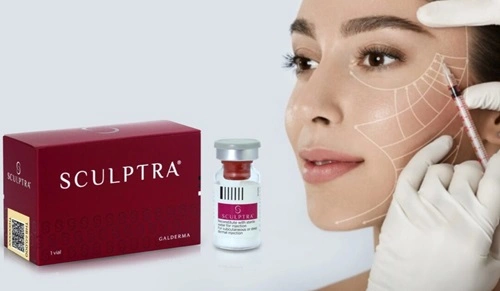When it comes to non-surgical cosmetic treatments, Sculptra has gained popularity as a long-lasting solution for facial rejuvenation. Unlike traditional dermal fillers, Sculptra stimulates the body’s natural collagen production, offering gradual and natural-looking results. Used to address signs of aging such as wrinkles, fine lines, and volume loss, Sculptra provides a minimally invasive way to enhance facial contours.
However, as with any cosmetic procedure, there are both benefits and drawbacks to consider. In this article, we will explore the pros and cons of Sculptra, helping you decide if this treatment aligns with your aesthetic goals.
What is Sculptra?

Sculptra is an injectable cosmetic treatment made from poly-L-lactic acid (PLLA), a biocompatible and biodegradable substance. Approved by the FDA, Sculptra works by stimulating the production of collagen, a protein that provides skin with structure, elasticity, and a youthful appearance. Unlike traditional fillers, which provide immediate volume, Sculptra’s effects develop gradually over several weeks or months as collagen builds up in the treated areas.
Sculptra is commonly used to:
- Reduce facial wrinkles and folds.
- Restore volume to sunken cheeks or temples.
- Improve the appearance of nasolabial folds (smile lines).
- Treat hollow areas under the eyes or along the jawline.
- Enhance skin texture and elasticity.
The Pros of Sculptra
1. Stimulates Natural Collagen Production
One of Sculptra’s biggest advantages is its ability to stimulate the body’s natural collagen production. This leads to gradual and lasting improvements in skin firmness, texture, and volume. Unlike temporary fillers, Sculptra helps the skin rejuvenate itself over time.
2. Long-Lasting Results
The effects of Sculptra can last up to two years or longer, making it one of the longest-lasting cosmetic injectables on the market. This durability reduces the need for frequent maintenance treatments, saving both time and money in the long run.
3. Natural-Looking Results
Sculptra’s gradual results offer a more natural appearance compared to some other treatments. Since the changes occur over weeks or months, the improvement looks subtle and avoids the “overdone” appearance sometimes associated with traditional fillers.
4. Minimally Invasive
Sculptra is a non-surgical procedure, meaning there’s no need for incisions, stitches, or extended recovery time. It involves a series of injections, making it a convenient option for individuals seeking facial rejuvenation without the risks of surgery.
5. Versatile Treatment Areas
Sculptra can be used on various parts of the face, including the cheeks, temples, jawline, and nasolabial folds. It’s also sometimes used on the body, such as for buttock enhancement or improving the appearance of cellulite.
6. Quick Procedure
A typical Sculptra session lasts about 30 to 60 minutes, depending on the treatment area. This makes it an excellent option for busy individuals who want to fit the procedure into their schedule without significant downtime.
7. Safe and FDA-Approved
Sculptra has been FDA-approved since 2004 for cosmetic use, with a strong safety profile. Its main ingredient, poly-L-lactic acid, is biocompatible and has been used in medical applications for decades.
8. Customizable Treatment
Each Sculptra treatment plan is tailored to the individual’s needs. The number of sessions, injection sites, and volume used can be adjusted to achieve the desired outcome.
9. Encourages Overall Skin Health
By boosting collagen production, Sculptra improves skin elasticity and texture. This not only reduces wrinkles but also enhances the skin’s overall health and resilience.
10. Low Maintenance
After completing the initial series of treatments, patients typically only need occasional maintenance sessions to preserve their results. This makes Sculptra a convenient option for long-term facial rejuvenation.
The Cons of Sculptra
1. Gradual Results
While Sculptra’s gradual results are an advantage for some, others may see this as a drawback. Unlike traditional fillers that provide instant volume, Sculptra takes several weeks or months to show noticeable improvements, which may not satisfy those seeking immediate results.
2. Higher Initial Cost
Sculptra treatments can be more expensive upfront compared to other injectables. Each session can cost between $700 and $2,000, and multiple sessions are typically required to achieve optimal results. However, the long-lasting effects may offset the higher initial investment over time.
3. Requires Multiple Sessions
Most patients need a series of three to four sessions spaced several weeks apart to achieve their desired results. This requires commitment and planning, which may not be ideal for those looking for a one-time treatment.
4. Temporary Swelling and Bruising
As with any injectable treatment, Sculptra can cause temporary side effects such as swelling, bruising, redness, or tenderness at the injection sites. These effects usually resolve within a few days but may be bothersome for some individuals.
5. Not Ideal for Severe Volume Loss
While Sculptra is effective for mild to moderate volume loss, it may not provide enough correction for individuals with significant sagging or deep wrinkles. In such cases, surgical procedures or other treatments might be more suitable.
6. Requires Skilled Provider
The success of Sculptra depends heavily on the expertise of the provider. Incorrect injection techniques can lead to uneven results, overcorrection, or lumps. It’s crucial to choose a board-certified professional with experience in administering Sculptra.
7. Risk of Nodules or Lumps
In rare cases, Sculptra can cause the formation of small lumps or nodules under the skin, particularly if the injections are not evenly distributed. Proper massage after treatment and following the provider’s instructions can help minimize this risk.
8. Limited Use for Certain Areas
Sculptra is not suitable for use in certain areas, such as the lips or the area directly under the eyes. Patients seeking treatment for these regions will need to explore alternative options.
9. Not Permanent
While Sculptra’s results are long-lasting, they are not permanent. Maintenance treatments are required every few years to sustain the effects, which may not appeal to those seeking a permanent solution.
10. Not Suitable for Everyone
Sculptra is not recommended for individuals with autoimmune diseases, allergies to any of its ingredients, or certain skin conditions. A consultation with a qualified provider is necessary to determine if Sculptra is a safe option.
Who Should Consider Sculptra?
Sculptra is ideal for individuals who:
- Want gradual, natural-looking facial rejuvenation.
- Are seeking a long-lasting, non-surgical solution for volume loss.
- Have mild to moderate wrinkles, fine lines, or facial hollowing.
- Are willing to invest time and money in a treatment plan.
- Prefer a minimally invasive procedure with little downtime.
However, it may not be the best option for those who:
- Want immediate results.
- Have severe volume loss or significant sagging.
- Are looking for treatments in areas like the lips or under the eyes.
- Prefer a one-time treatment without the need for maintenance.
Tips for Maximizing Sculptra Results
- Choose a Skilled Provider: Work with a board-certified professional experienced in Sculptra treatments to ensure safe and effective results.
- Follow Aftercare Instructions: Massage the treated areas as directed by your provider to promote even distribution of the product and reduce the risk of lumps.
- Be Patient: Understand that Sculptra’s results take time to develop and plan your treatments accordingly.
- Schedule Maintenance Sessions: Maintain your results by scheduling follow-up treatments every two to three years.
- Stay Hydrated: Proper hydration can help improve the overall health and elasticity of your skin, enhancing the effects of Sculptra.
Conclusion
Sculptra offers a unique approach to facial rejuvenation by stimulating natural collagen production for long-lasting and natural-looking results. Its gradual effects, versatility, and ability to improve overall skin health make it a popular choice for those seeking a minimally invasive treatment. However, its higher cost, multiple-session requirement, and potential side effects may not suit everyone.
By weighing the pros and cons of Sculptra, you can determine whether this treatment aligns with your aesthetic goals and expectations. For many, Sculptra represents a valuable investment in restoring youthful vitality and confidence.


